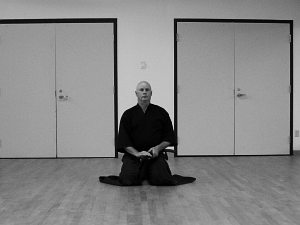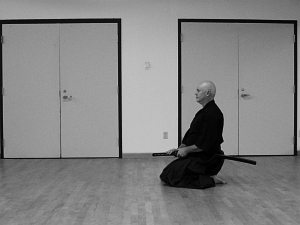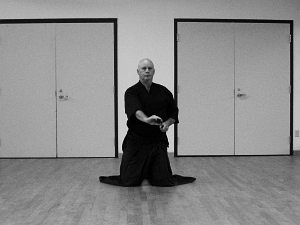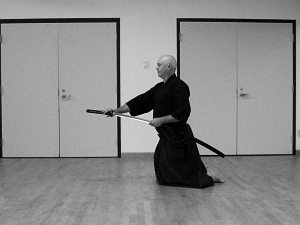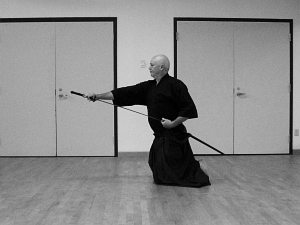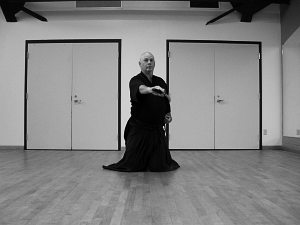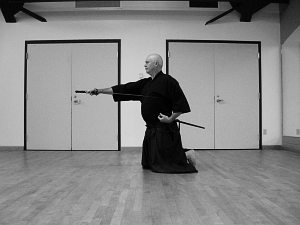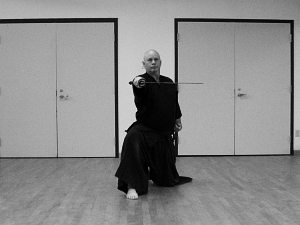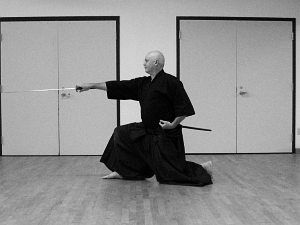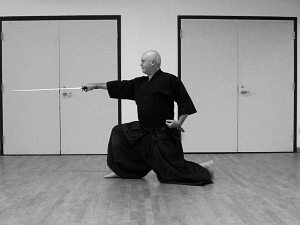Down to the Count
copyright
© 2010 Kim Taylor, all rights reserved
The draw in the first ZNKR iaido kata (Mae) is often broken down into
several steps to allow students to examine their technique.
In my own classes I have usually broken the draw into three parts, 1:
the draw, 2: the close of the fingers and 3: the opening of the chest /
closing of the shoulderblades. This allows students to understand the
shape of the opening cut, which is to draw toward the opponent, then
cut at the maximum distance away with power and accuracy. The details
are given below in the photographs if you are unfamiliar with iaido.
There is a potential problem with teaching this way, especially if a
student is introduced to the concept without subsequent observation by
the instructor. He may assume that this is "the way" to cut, and
misunderstand that it is a break-down of the mechanics to allow them to
be examined separately. In other words, his cut becomes a mechanical
1-2-3 movement where the hand is stretched to its maximum before the
arm is moved across the body. The result is a weak cut which is
"digital", it has discrete movements, rather than "analogue". The
maximum power is traded off to a certain extent with the maximum
distance from the body. The hand must be closing through its maximum
power range while the sword tip is cutting across the target, and since
the maximum power of any muscle is somewhere around 2/3 of its
contraction range, that means the hand is not completely finished
moving before the shoulders are moved during the cut.
Part of the problem is in what I have called the "fallacy of expanding
time in kata". This is the idea that more and more steps can be
introduced into a combative movement without it breaking down. I first
noticed this in aikido practice where my partner would say "I can do
this here" and I would say "well then I would do this" and he would
counter with "well then I would do this". The fallacy of course is that
if someone is punching you in the head you usually don't have all day
to go through a range of movements and counter-movements, he punches,
you counter, he falls down is the most favourable outcome... or perhaps
he punches, you miss the counter, you go put some ice on your nose. The
fallacy of expanding time usually doesn't occur when one is in a
competitive art, there is not a lot of time for extended counters and
counter-counters when being thrown in judo or being hit in kendo, one
movement is often all there is time for. But in arts where the practice
is slowed down, in iaido or aikido for instance, one needs to be
careful.
Because ZNKR seitei iaido can be done slowly, with more emphasis on
correct form and posture than on speed, the student may get the idea
that one can spend the time to draw forward, close the hand and then
cut across with the back muscles when the reality is that the last two
movements actually occur in an overlap. Yes the hand is closed first
but the shoulder starts moving before the hand finishes its movement.
Recently, I attended a seminar with a hanshi hachidan instructor. This,
for those who don't know, is the top rank that exists in the kendo
federation right now. These few people define what the art is, how it
is practiced and taught, so they are worth listening to. In this
seminar I picked up three more counts for my examination of the initial
draw and cut in iaido, otherwise known as nuki tsuke, and I will
outline them below as counts 2, 3 and 4.
Fig 1
Here we begin the movement by sitting in seiza with the hands on the
thighs. I will take this opportunity to do some self correction and say
that the hands should be at the same position, having my right hand
ahead of the left is a bit aggressive. The back could be a bit more
straight as well, unless the top is not tucked in well enough. In
either case it should be fixed. Perhaps I should cut myself some slack,
I was posing for photographs and not performing the kata.
At this time the opponent (kasso teki) in front begins to make attacking movements or similar threats.
Fig 2
Count 1. The draw toward the opponent starts, the right hand
comes on in this relaxed position and the left thumb releases the blade
from the scabbard. As the blade is pushed out of the saya the hips
drive forward (which of course means that they will rise, but it is the
forward movement that is important). The blade remains edge up.
Fig 3
Count 2. Once the blade is half way drawn toward the
opponent the toes flip under and the left hand turns the saya so that
the blade moves into the correct position in the right hand for the
cut.
Fig 4
Count 3. This is called "saya banari" the position at which
the blade is turned to the horizontal position, the toes are flipped
down and the blade tip is just at the opening of the saya (the
koiguchi). This is the final position at which the opponent can say
"gomen", sorry, and the kata will finish without bloodshed. Of course
this does not happen with our invisible enemy and the cut is made
directly from the scabbard. This instant in time, saya banari or
"breaking the scabbard" can be taken as the specific definition of
iaido.
Fig 5
Count 4. I am an idiot, in this sequence we missed a step,
where the little finger of the right hand pushes the tip of the blade
up to shoulder height just as it is released from the koiguchi. I have
inserted other images here to show what I mean, you can see the tip
moving upward to horizontal.
Fig 6
Count 5. The hand is
closed so that the tip moves to the target. Note that in the photograph
the hand is extended to its finishing position as the target is
reached. This will make the next cutting movement weak as there is no
way for the wrist to move except back from the cut. If the next
movement is made just before this wrist position is reached, the
maximum distance forward will be slightly less, but the power in the
cut will be greatly increased.
Fig 7
Count 6. Finally, the chest is opened and the lower part of
the scapula is closed as a strong movement of the scabbard (saya biki)
is made so that the tip cuts across the target. Note that the hips
should be square to the opponent and the chest at about 45 degrees to
the left front. The tip of the blade stops just outside of the target
(the forehead or eyes) and so just in front of your right shoulder.
Breaking the nuki tsuke down to these six counts can be very useful to
a beginner, as each body motion can be studied separately, but I hope
that students of iaido will see the problem immediately. I stated above
that cutting directly from the koiguchi to the target is the definition
of iaido, The tip is released at saya banari, as the scabbard is broken
(hopefully not actually broken
since that would mean we just sliced our left palm), and the target cut
immediately. This obviously can't happen if we release the tip at
figure 4 and move it upward to figure 5 before cutting forward in
figure 6. What we really need to do here is combine these two
movements, the tip going forward and upward so that the tip moves on a
diagonal angle directly from the scabbard to the target. If you examine
figure 4 you will see that the line of the blade is more or less at
this this angle.
So here we have several photographs which correspond with six counts of
the draw and cut. Since this is a continuous movement (whether done
slow or fast) these images and my counts are a lie. The breakdown can
be of tremendous value to a student, but like most instructions, that
breakdown must be understood for what it is. The function of the
movement must never be far from the mind, and the function of nuki
tsuke is to cut the target strongly, efficiently and at a distance from
the body.
Kim
Taylor is a nanadan (7dan) in the Canadian Kendo Federation iaido
section. He is available for seminars in iaido, jodo and niten ichiryu.
http://seidokai.ca/


